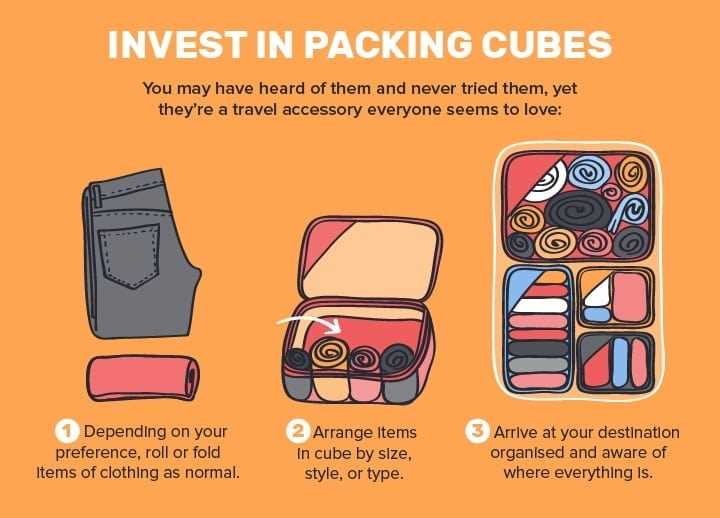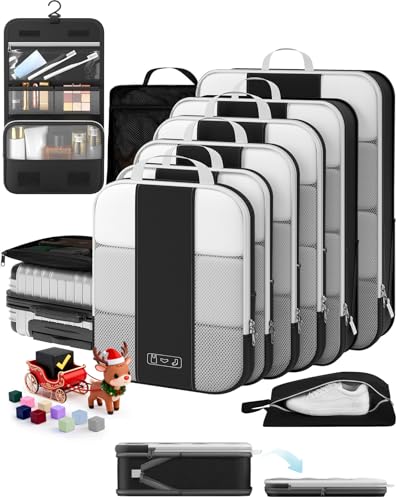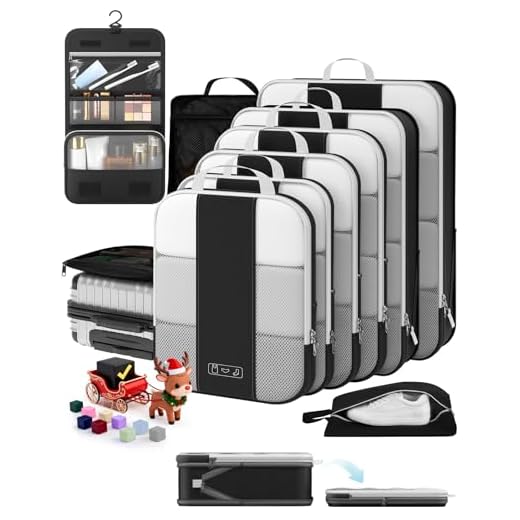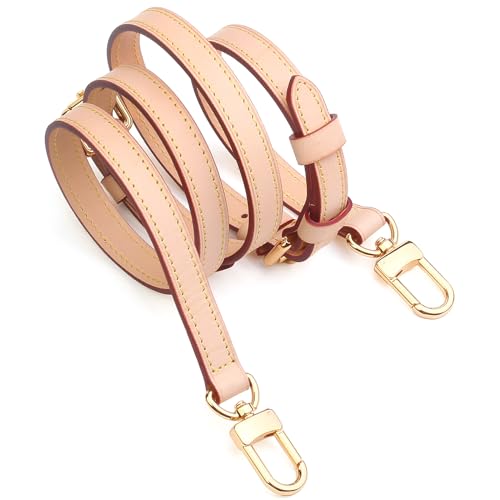


Begin by rolling your garments instead of folding them. This approach minimizes creasing and maximizes space within your suitcase. In this article, I’ll share various strategies to optimize your travel gear arrangement, ensuring you can fit all essentials without the hassle of overpacking.
These tips will benefit anyone preparing for a trip, whether it’s a weekend getaway or an extended vacation. By implementing these practical solutions, you can travel lighter and more organized.
The article covers methods like compression packing, utilizing packing cubes, and strategic layering of items. Each technique is designed to help you make the most of your available space while keeping your belongings accessible and orderly. Say goodbye to the stress of disorganized bags and hello to a smoother travel experience.
Best Luggage Packing Techniques
Utilizing compression bags is an excellent strategy to maximize space within your travel container. These bags allow you to remove excess air, effectively reducing the volume of your clothing and other soft items. This not only saves space but also helps keep your belongings organized and wrinkle-free.
Rolling clothing instead of folding is another practical approach. This technique minimizes creasing and allows for more efficient use of space. By placing rolled items in strategic layers, you can create a compact arrangement that maximizes every inch of available area.
Additional Strategies
- Use packing cubes: These are perfect for separating items by category or outfit, making it easier to find what you need without rummaging through everything.
- Fill gaps: Make use of every available space, such as inside shoes or between larger items, to pack smaller accessories and toiletries.
- Wear bulky items: For heavier clothing such as jackets or boots, consider wearing them during transit to save space in your container.
When it comes to toiletries, opt for travel-sized containers. This not only complies with regulations but also reduces weight and space occupied in your bag. Use a toiletry bag with compartments for better organization.
- Start with heavier items at the bottom.
- Layer lighter clothing on top.
- Place fragile items in the center, cushioned by softer materials.
By implementing these techniques, you can optimize your travel experience, ensuring that you have everything you need while maintaining a manageable load.
Maximizing Space with the Rolling Technique
The rolling technique is a highly effective way to conserve space in your travel bags, allowing for a more organized and compact arrangement. This method involves tightly rolling clothing items instead of folding them, which reduces bulk and minimizes wrinkles.
To utilize this technique, begin by laying out each garment flat. Start from one end and roll the item tightly towards the other end, ensuring there are no loose areas. This not only saves space but also makes it easier to see and access your belongings once packed.
Benefits of the Rolling Technique
- Space efficiency: Rolling items can save significant space, especially with thicker fabrics.
- Wrinkle reduction: Tightly rolled clothes are less likely to crease compared to folded items.
- Organization: Rolled items can be stacked neatly, making it easier to find specific pieces.
For optimal results, consider the following:
- Group similar items: Roll together t-shirts with t-shirts, pants with pants to streamline packing.
- Use packing cubes: These can help separate rolled items while maximizing space.
- Layer strategically: Place heavier items at the bottom and lighter ones on top for better balance.
This technique is suitable for various types of clothing, from casual wear to formal attire. By mastering this method, travelers can enjoy a well-organized bag without sacrificing essential items.
Utilizing Packing Cubes for Organization
Packing cubes serve as an excellent solution for maintaining order within your travel gear. These compartments allow you to categorize items by type or purpose, reducing clutter and simplifying access during your trip.
By grouping similar items together, you can save time and effort when searching for specific clothing or accessories. This method not only enhances organization but also optimizes the use of space within your suitcase.
Benefits of Packing Cubes
- Space Optimization: Fitting more items into your suitcase becomes easier with packing cubes, as they compress clothing and provide structure.
- Quick Access: Finding what you need is straightforward when items are categorized, minimizing the time spent rummaging through your belongings.
- Preventing Wrinkles: Keeping clothes neatly folded within cubes helps maintain their appearance, reducing the need for ironing upon arrival.
- Separation of Dirty and Clean Clothes: Designating specific cubes for worn items can streamline your unpacking process and maintain freshness.
To maximize the advantages of using these compartments, consider the following tips:
- Choose sizes that fit your suitcase dimensions for optimal use of space.
- Label each cube if necessary, making it easier to identify contents at a glance.
- Roll clothing instead of folding to further save space and reduce wrinkles.
- Utilize different colors or patterns to distinguish between categories like clothing, toiletries, and electronics.
Incorporating packing cubes into your travel routine can transform the way you organize and manage your essentials, leading to a more enjoyable and stress-free experience.
Efficient Folding Strategies for Clothing
Rolling clothes is a highly effective technique that minimizes wrinkles and maximizes space. Begin by laying the garment flat and folding the sleeves inward. Roll from the bottom to the top tightly, ensuring the roll retains its shape. This approach not only saves space but also allows for easy organization within your travel container.
Another useful technique involves the bundle method. Start by laying a larger item, such as a jacket, flat. Place smaller items, like shirts and pants, on top, creating a stack. Then, wrap the larger item around the smaller ones, creating a tight bundle. This method reduces creasing and allows for a compact arrangement.
Specific Techniques to Consider
- Flat Folding: For items like dress shirts, fold the sides toward the center, then fold the bottom up. This keeps collars crisp and prevents wrinkles.
- Folding with Interleaving: Place a tissue or plastic sheet between layers of clothing to minimize friction and reduce wrinkles during transit.
- Compression Bags: Use these bags for bulkier items. They can significantly reduce the space occupied by sweaters or jackets.
Implementing these strategies will not only enhance your organization but also protect your garments during travel.
Incorporating Compression Bags for Bulk Reduction
Utilizing compression bags can significantly minimize the volume of clothing and other soft items, making them an invaluable addition to any travel strategy. These bags work by removing excess air, allowing you to fit more into limited space, which is particularly beneficial for bulkier items like jackets or sweaters.
To maximize their effectiveness, first, roll the clothing tightly before placing it into the compression bag. This technique not only enhances the space-saving potential but also helps to minimize wrinkles. Once the items are inside, seal the bag and use a vacuum or simply roll it to push out the air, ensuring the bag is as compact as possible.
Benefits of Compression Bags
- Space Efficiency: Drastically reduces the amount of space taken up by clothing in your suitcase.
- Organization: Keeps similar items grouped together, making it easier to find what you need.
- Protection: Offers a layer of protection against moisture and dirt.
When selecting compression bags, consider the material; thicker, durable options tend to hold up better over time. Additionally, be cautious not to overpack the bags, as this can lead to difficulties in sealing them properly. A well-maintained approach to using compression bags can lead to a more streamlined and manageable travel experience.
Strategic Placement of Essentials for Quick Access
Place frequently used items in easily reachable compartments. This minimizes the time spent rummaging through your belongings and allows for a more organized experience while traveling.
Consider using packing cubes or pouches to categorize your items. This not only keeps everything tidy but also simplifies the process of locating specific items quickly.
Prioritizing Accessibility
Identify the essentials you may need during transit, such as travel documents, electronics, chargers, and personal care items. These should be positioned at the top or in external pockets of your bag.
- Documents: Keep passports, tickets, and itineraries in a designated pocket.
- Electronics: Store phones, tablets, and chargers in a compartment that is easy to access.
- Personal care: Place toiletries and medications at the forefront for convenience.
When packing clothing, roll items to save space and create a compact form. Place heavier garments at the bottom to maintain balance and prevent damage to delicate belongings.
Utilizing Every Space
Fill gaps with smaller items like socks or accessories. This maximizes space and prevents movement within the bag, which can lead to wrinkling or damage.
Consider the layout of your travel route. If you have layovers or multiple stops, plan your packing accordingly to ensure that items needed during the journey are easily accessible.
Protecting Fragile Items During Travel
Wrap each delicate item in bubble wrap or soft clothing to minimize impact during transit. Ensure that these items are placed in the center of the bag, surrounded by softer materials to absorb shocks.
Use sturdy containers or original packaging whenever possible. This provides an additional layer of protection and helps maintain the integrity of the item.
Key Strategies for Safeguarding Fragile Objects
- Layering: Place fragile items between layers of soft clothing or padding. This creates a buffer against external pressure.
- Separation: Keep delicate items away from heavier objects to prevent crushing.
- Sturdy Cases: Invest in hard-shell cases for particularly fragile items like electronics or glassware.
- Labeling: Mark your bag as containing fragile items to alert handlers during transport.
- Insurance: Consider travel insurance for valuable fragile items, ensuring compensation in case of damage.
By incorporating these strategies, you can significantly reduce the risk of damage to your fragile belongings. Careful preparation and thoughtful organization are key to ensuring that your items arrive at your destination intact.
Best luggage packing methods
Features
| Model | PCC7V101 |
| Color | Black |
| Size | 10 set |
Features
| Model | X8-3H-NZ-us |
| Color | Grey with Orange accents |
| Release Date | 2025-07-01T07:00:00.000Z |
| Size | 15-Piece Set |
Features
| Model | ComPK290 |
| Color | 06-Black |
| Size | 13.75 inches x 12.75 inches x 4.5 inches |
Video:
FAQ:
What are some effective methods for packing luggage for a trip?
There are several methods to efficiently pack your luggage. One popular technique is the rolling method, where you roll your clothes tightly to save space and reduce wrinkles. Another approach is the layering method, which involves stacking items in a way that maximizes space and keeps items organized. Packing cubes are also a great tool to compartmentalize your belongings, allowing for easy access and organization. Lastly, consider using compression bags to minimize the volume of bulky items, like jackets or sweaters.
How can I make the most of my suitcase space without overpacking?
To maximize suitcase space while avoiding overpacking, start by creating a packing list of essentials. Choose versatile clothing items that can be mixed and matched. Use every inch of your suitcase by filling shoes with socks or small items. Limit the number of shoes you bring, as they can take up significant space. Additionally, consider wearing your bulkiest items, like a jacket or boots, during travel to lighten your load. This will help you stay organized and ensure you have everything you need without excess baggage.
What items should I prioritize packing for a long trip?
For a long trip, prioritize packing items that are versatile and necessary for your destination’s climate. Start with essential clothing pieces, such as comfortable outfits for various occasions, sleepwear, and undergarments. Don’t forget a lightweight jacket or sweater for cooler evenings. Toiletries should be travel-sized to save space, and consider bringing a small first-aid kit for emergencies. Electronics, along with their chargers, should also be packed, as well as any travel documents. Finally, include a small bag for dirty laundry to keep your suitcase organized throughout the trip.
Are there any tips for packing fragile items in luggage?
When packing fragile items, it’s crucial to protect them to avoid breakage. Start by wrapping each fragile item in bubble wrap or clothing to cushion them during travel. Use a sturdy suitcase with a hard shell for added protection. Place the fragile items in the center of your luggage, surrounded by soft items like clothes to absorb shock. Avoid placing heavy items on top of fragile ones. Lastly, clearly label your luggage as containing fragile items, if possible, to alert handlers to take extra care.








